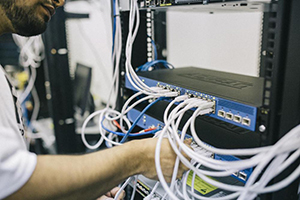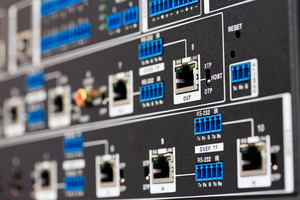Managed and unmanaged network switches differ in various aspects, including control and cost. Managed switches have more features than unmanaged switches, but they also require skilled administrators or engineers to take full advantage of them. Managed switches provide greater control over the network and the data frames moving through them. Unmanaged switches, on the other hand, enable connected devices to communicate with each other in their most basic form.
What is an unmanaged switch?
Unmanaged switches use auto-negotiation ports to determine parameters such as data rate and whether to use half- or full-duplex mode. Also, unmanaged switches do not have the concept of virtual LANs (VLANs). Therefore, all devices belong to the same broadcast domain.
However, unmanaged switches do maintain a table of media access control (MAC) addresses. This table tracks dynamically learned MAC addresses and the corresponding switch ports that learned the MAC addresses. Including the MAC address table means that the unmanaged network switch provides a separate, per-port collision domain. A collision occurs when two devices in the same domain try to send data at the same time. If this happens, the switch drops both packets and the end device is forced to retransmit. A collision domain is a layer 2 network boundary where a device can send a broadcast frame and reach all devices within that segment.
What is a managed switch?
Managed switches allow users to adjust every port on the switch to any setting, allowing them to manage, configure, and monitor the network in multiple ways. They also provide greater control over how data is transferred across the network and who can access that data. Managed switches typically provide Simple Network Management Protocol (SNMP), enabling users to monitor the status of the switch and individual switch ports, and provide statistics such as traffic throughput, network errors, and port status.
Network administrators can track this data over time and use it for troubleshooting and network capacity purposes. Managed switch ports can be configured as trunks, a process that tags data frames with a VLAN ID and transmits multiple VLAN frames over a single link. Trunk ports are typically used to connect two switches together or to connect a switch to a VM server that needs to access multiple VLANs. Administrators can also virtually combine multiple ports to form port aggregated links that deliver twice, four, and eight times the speed of a single link. Finally, managed network switches often have a remotely accessible console—command line or web interface—that enables administrators to make configuration changes or adjustments from different physical locations.
Key Differences Between Managed and Unmanaged Switches
As the name suggests, one of the main differences between managed and unmanaged exchanges is their approach. Managed network switches provide network administrators the flexibility to control, manage, and prioritize LAN traffic. However, an unmanaged switch works like a plug-and-play switch, allowing devices on a LAN to communicate with each other without user intervention. The following points will help you understand other key points between these two network switches:
Configuration freedom:
Managed switches allow users to manage, configure, and monitor the LAN. They allow users to create new LANs and isolate smaller devices and help users manage traffic efficiently. Managed network switches have advanced features that allow users to recover data in the event of a device or network failure. They also allow data recovery.
Unmanaged switches may be easy to use, but they have fixed configurations, which means you can’t change the network. This is why it is most commonly used in startups with limited data exchange.
Performance management:
Unmanaged network switches are plug-and-play switches. They have built-in QoS services, which ensure that they are easy to set up and practical. However, managed network switches allow you to manage performance by prioritizing channels. It utilizes protocols such as Simple Network Management Protocol (SNMP) to monitor the performance of all devices connected to the LAN on an Ethernet network. Managed switches also use SNMP to analyze the current performance of devices on the network through an easy-to-understand graphical interface. In addition, SNMP enables remote management of connected devices and networks without physical intervention on the switch.
Security function:
Unmanaged switches have basic security features, such as lockable port covers, which ensure basic security and help avoid any kind of direct tampering with the device. However, managed network switches are equipped with advanced features that help identify active threats and shut them down on time, and protect data and controls.
Cost:
The price range of unmanaged network switches is affordable, while managed switches are pricier due to their advanced features.
How to choose between managed and unmanaged network switches
The following tips will help you make the right decision:
Scalability: Is the business and network expected to grow in the future? If yes, then you probably need several managed network switches that can be manually configured and allow for scalability.
Performance and Speed: If you’re a startup looking to minimize your upfront investment, an unmanaged switch is a better option. However, if you have to transfer a lot of data on a regular basis, a managed switch can do it.
Security: While limited data is transmitted over the network, this information can be sensitive and you don’t want it to be tampered with. In this case, a managed switch is the best option.
| Features | Managed Switches | Unmanaged Switches |
| Control | Managed switches provides flexibility to the network administrator | Unmanaged switches works like a plug and play switch |
| Security | Provides extensive set of security features | Provides basic set of security features |
| Configuration | Managed network switch has advanced features which allows users to manage, configure, and monitor | Unmanaged network switch comes with fixed configuration |
| Performance Monitoring | Uses (SNMP) to monitor the performance | Built-in QoS services |
| Cost | More Expensive | Less Expensive |
What is a better managed or unmanaged switch?
The information provided in this article can help you understand the features and key benefits of managed and unmanaged network switches and help you make decisions. Knowing this, it’s also important to source them from trusted brands. Router-Switch offers unmanaged and managed fabric switches in various configurations.Use the switch selector to choose the most suitable switch.
Want to know more, please click here: SMB Switches, Industrial Ethernet Switches, Cisco Switches, HPE Switches
Read More:
Difference between Router and Switch
H3C Switches Commands: Reset, Trunk, and Basic Commands
Ubiquiti Unifi vs EdgeSwitch – Which one is more suitable for home?







